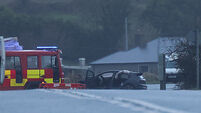Japan praises new quake alert system
Authorities hailed Japan’s new earthquake alert system a success today after it allowed officials to issue a tsunami warning just one minute after a magnitude-6.9 quake jolted the country’s coast.
Yesterday’s quake killed one person and injured 193 others, but officials said the one-minute warning provided a potentially life-saving edge over the three minutes required by the country’s older alert system.
Strong aftershocks shook the region today and authorities in the town of Wajima, near the epicentre, said a lack of safe drinking water had become a top concern.
One magnitude-5.3 aftershock struck in the morning, but there was no tsunami danger, Japan’s Meteorological Agency said. The agency said strong aftershocks could continue for a week.
“A fairly big aftershock hit just minutes ago and I jumped out of the door,” said Tomio Maeda, manager of a convenience store in Anamizu town.
Yesterday’s quake struck undersea off central Japan, along the Noto Peninsula that juts into the Sea of Japan. The earthquake toppled buildings, triggered landslides, cut electricity, snapped water mains and disrupted transportation throughout the region.
It also triggered a small tsunami about six inches tall that hit shore 36 minutes later.
Although the wave did not cause any damage, authorities were able to give an early warning because of a more sensitive earthquake detection system that Japan has been using since last October.
The new system can detect slight tremors that travel underground ahead of a larger quake, Meteorological Agency official Yosuke Igarashi said.
Yesterday’s quake was the first time the system has been used to issue a tsunami warning.
“Before the new system went into effect, it took about three minutes to get out a tsunami alert. On Sunday, we were able to get the alert out within a minute, so I’d say it was a success,” Igarashi said.
The Meteorological Agency expects the new system will reduce earthquake injuries and damage by allowing authorities to quickly shut down lifts and trains and evacuate factories, offices and other buildings rapidly.
Prime minister Shinzo Abe told a parliamentary committee today that the quake had knocked down at least 68 homes and partially destroyed another 164.
A 52-year-old woman was crushed to death by a falling stone lantern and at least 193 other people were injured, most of them hurt when they fell or were hit by falling objects and broken glass.
The Fire and Disaster Management Agency said most of the injuries and damage occurred in Wajima, about 193 miles north west of Tokyo.
More than 4,000 households were without water, and damage to roads made it difficult to truck in supplies, city official Kazuharu Kaji told public broadcaster NHK.
“Water is in extremely short supply,” Kaji said. “In particular, there are dialysis patients and others at local hospitals who may not be able to receive treatment because of the shortage.”
The affected area had not suffered a major quake since 1933, but Japan’s nationally circulated Yomiuri newspaper said in an editorial that yesterday’s quake should make it clear that “there is no place in Japan where an earthquake could never happen” and urged the government to take stronger anti-quake measures.














